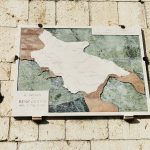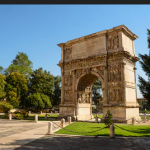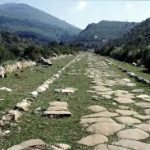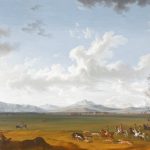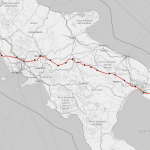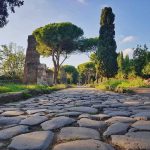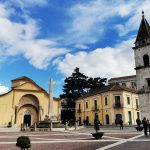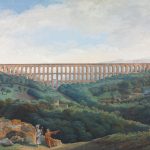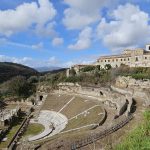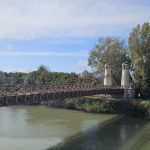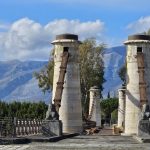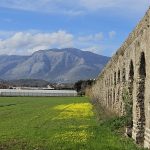Via Appia - the ‘Via Francigena del Sud’ - from Formia to Benevento - VFS 2
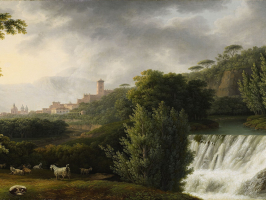 |
|
||||||||||||||||||||||
The Via Appia & the Via Francigena in northern Campania
Along this stretch of the Via Appia you’ll enter the region of Campania, the area which was called Campania Felix, or ‘Happy Land’ by the Romans. It’s a relatively unknown part of this region (which is best known for Naples & the Amalfi Coast), but it is also a part of the region where the intriguing history of the area comes most alive.
Here, more than ‘only’ walking over a medieval pilgrim’s route, the ‘Via Francigena del Sud’, you’ll walk along the main highway of the Roman Empire, a route travelled since 2000 years! At first you’ll travel through the plain of the ‘Campania Felix’, the area where the rich and famous of the Roman Empire travelled to for their ‘otium’, leisurely holiday time. An indication of the importance of this area in those times are its amphitheatres: some of the world’s biggest can be found here.
When it’s come to spending a leisurely time also the Bourbon Kings of Naples knew how to do this: in Caserta you’ll find their stupendous summer palace, the ‘Versailles of Naples’. Then the road bends more inland and enters the heartland of the Sanniti, an ancient civilisation which flourished in this area before the rise of the Roman Empire. Only after a long series of battles the Romans were able to conquer this area, and definitely settled in the area of Benevento.
In additional to all this history, this area also features a great number of natural wonders, due to its very diverse nature. You’ll first walk along the coast, in the shadow of the towering Aurunci Mountains (short detour possible), then cross the river plain of the Volturno and enter the area of the Roccamonfina volcano. Your route continues through a pleasant hilly landscape of olive groves and vineyards after which you’ll visit the unknown Taburno Mountains, before entering the beautiful city of Benevento, in the plain of the River Calore.
Of course on our tours, we try as much as possible to avoid the busier area. However, some areas are a bit busier, and in case you want to follow the Via Appia closely, you will enter the agglomeration of Santa Maria Vetere and Caserta, where you will be walking for two days through an urbanised area – busy, but also beautiful and tremendously interesting! Some busier parts can possibly be avoided using the public transport. However we have already selected the quietest routes, and even within the city boundaries of Rome you’ll be walking in beautiful forests.
There are several possible routes: the ‘official’ route of the Via Francigena, an alternative route, as well as a route which follows the ancient Via Appia more closely.
Please contact us to know about the actual possibilities.
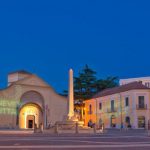 |
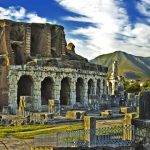 |
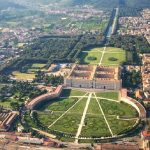 |
This is a moderately challenging tour which is suitable for experienced walkers with a good general physical condition. Roughly following the traces of the Via Appia, one of Europe’s most ancient ‘highways’, in Roman and medieval times, you walk from village to village, a full immersion in the unknown northern part of the Campania region,
Programmes
Although there is an ‘official’ route of the Via Francigena – with a designated number of stops along the road – and the Via Appia follows a well-known route, it is not always necessary to follow one of these. We will be able to ‘personalise your route, according to your time available.
Day 1
Arrival in Formia. Either on foot, in case you walked the Via Appia from Rome, or by train from Rome (or Naples, in case you start your walking tour from here). Depending on your arrival time, you can go for a short visit to the centre of town and perhaps down to the harbour.
B&B – Formia
Approx. walking time: 1 h. + sightseeing time.
Optional Extra Day – Gaeta or Formia
Before starting to walk from Formia, you could opt to stay an extra day at the coast in either Gaeta or Formia. We definitely recommend to make a detour and visit the beautiful town of Gaeta. Gaeta has a nice medieval town centre, dominated by a grand castle and which offers also beautiful walking through the nature reserve of Monte Orlando, not only rewarding for its great views over the Mediterranean, but also for its Roman vestiges. Also Formia, although it does not look attractive from the outside, has a very interesting centre, built on Roman foundations. You’ll have the choice to either stay in Formia or Gaeta for tonight.
B&B/Hotel***/**** – Formia/Gaeta (many options possible)
Day 2
Today starts with a relatively busy stretch along the coast, still following the Roman Via Appia, which here has become a busy road. Soon however you’ll have the possibility to leave the road and enter the beautiful nature reserve of Gianola, one of the most interesting ‘cultural nature reserves’ of the area. Here you’ll have the possibility to climb up the Monte scauri, for some amazing views over the area, and visit the small Roman harbour. You’ll exit the nature reserve at the other end, near the small town of Scauri and then follow the coast to the Marina di Minturno. Just beyond the modern marina you’ll reach the Roman city of Minturnae, an important stop on the ‘Via Appia’, on the benches of the Garigliano River, the border between Latium and Campania. A visit to these ancient vestiges of the Rome’s glorious past is definitely worth it, before settling in your hotel.
Hotel *** – Minturno
Distance: 20 km. Approx. 5 h. walking + sightseeing time. Ascent & descent: + 100 m./- 120 m.
Day 3
Leaving Latium, you’ll cross the beautiful bridge over the Garigliano River, the first suspension bridge in Europe, a masterpiece of engineering, from the times that Naples was still a Kingdom. You now stop following the coast and bear inland into the fertile plain of the Garigliano and Volturno Rivers, once known as the ‘Campania Felix’, the Happy Land. After a few hours walking through the plain, the landscape becomes hillier. Through a pleasant agricultural landscape you reach the beautiful small town of Sessa Aurunca. This was already an important place in Roman times, but its main monuments are the medieval palace and cathedral. Take your time to look around in the nice historical centre, before settling in your hotel.
B&B – Sessa Aurunca
Distance: 22 km. Approx. 6 h. walking + sightseeing time. Ascent & descent: + 300 m./- 100 m.
Day 4
After a leisurely breakfast you can still spend some time to look around in Sessa Aurunca, before leaving it in eastern direction. Today’s walk brings you along the southern slopes of the Roccamonfina volcano, unlike the nearby Vesuvius no longer active, but with an equally rich volcanic soil which gave birth to an intensive agriculture and beautiful chestnut forests. Our route will now leave the Via Appia (which goes further south through some densely populated areas around the city of Caserta – on request we could as well offer this route – see below). After Sessa Aurunca you’ll pass several small villages along the way and towards the end of the afternoon you’ll arrive in the small town of Teano. According to Italian history books this is the place where King Vittorio Emanuele II met with Garibaldi in 1860, the meeting which gave birth to the Italian State. You can either stay in a hotel in Teano, or in a nearby agriturismo.
B&B – Teano
Distance: 16 km. Approx. 4-5 h. walking + sightseeing time. Ascent & descent: + 350 m./- 400 m.
Day 5
Today’s route brings you from the volcanic soils into the limestone mountains. First you walk down into the valley, where you’ll cross the ‘Autostrada del Sole’, after which you climb up to the village of Riardo, the ‘mineral water capital’ of Italy. If you wish you can make a short detour to the sources (or through nearby Rocchetta). You then continue to the small villages of Pietramelara and Roccaromana, dominated by the Norman Tower on a prominent hilltop.
Hotel *** – Roccaromana (Pietramelara)
Distance: 15 (20) km. Approx. 4 (6) h. walking + sightseeing time. Ascent & descent: + 300 m./- 200 m.
N.B. For those who wish a beautiful loop through the archaeological area of Cales, the olive groves of Caiazzo, a beautiful ‘Slowfood’ town and the vineyards of Castel Campagnano can bring you to Telese Terme as well. This route takes as well three days– just like the ‘original’ route along Alife and Faicchio – but can be turned into a 2-days walk.
Day 6
This morning you descend to Statigliano, then walk through the hilly countryside, but then halfway the day you’ll descend to the plain of the Volturno River, Campania’s longest river. After a short stretch through the plain (optional short train ride) you’ll cross the river and in the afternoon you’ll arrive at the town walls of the city of Alife, in the shadow of the towering Matese Mountains, the highest tops of the Campania region. The city, of Samnite origins, has become an important place under the Roman occupation and has preserved the Roman lay-out.
Worth a visit are the Roman amphitheatre, which was the fourth largest in Italy after those of Rome, Pompeii and Capua, as well as several mausoleums and the Roman Cryptoporticum, a well-preserved gallery more than 100 metres long, the Lombard castle and the Alife Cathedral (1132). You either sleep in town or in an agriturismo a bit further, on the way to Faicchio.
B&B /Agriturismo – Alife
Distance: 17 (20) km. Approx. 5-6 h. walking. Ascent & descent: + 300 m./- 450 m.
Extra Loop through the Matese National Park (Day 5 – 6)
Although not on the route of the Via Francigena, nor on the Via Appia, the beautiful Matese Mountains, on the border between Campania and Molise are definitely worth a visit. From Alife you can travel up to Piedimonte Matese and from there towards its lake, in the heart of the National Park. Several stunning roundwalks are possible here, including one to the highest point of Campania, Mt. Miletto, as well as great overnight stays in a beautiful agriturismo.
Agriturismo or Hotel***/**** – Matese
Day 7
Today is a relatively short walk, but there is a lot to see along the road!. At the exit of the town of Alife, you first pass the amphitheatre, and then continue your walk through the plain. Halfway the morning the route becomes hillier again and you’ll walk up at the nice town of Gioia Sannitica. From the it’s a short, but mountainous walk along the Convent of San Pasquale, down to the beautiful small town of Faicchio, dominated by its impressive castle. Here you can opt for either a nice Bed&Breakfast ‘downtown’, or an agriturismo just outside the village.
B&B – Faicchio
Distance: 18 km. Approx. 5-6 h. walking. Ascent & descent: + 300 m./- 250 m.
N.B. For those who stay overnight already beyond Alife, it’s possible to walk directly to Telese, a longer (almost 30 km.) but feasible walk with only some climbing, then most downhill to the end).
Day 8
The first part of the walk goes through the rolling hills, before uou start a slow and gradual descent towards the thermal resort town of Telese Terme. Just before entering the town you’ll enter the nature reserve of Montepugliano, an interesting area of small volcanic cones. Telese is one of southern Italy’s foremost spa resort, so it could be a nice place to relax, and even could you take time for a spa treatment. There is a little lake, in a park-like landscape, a great place to relax. It’s only a short walk, so in alternative you can decide to walk on another few km., cross the Calore River and stay overnight in the wine town of Solopaca, in the foothills of the Taburno Mountains.
B&B/Hotel *** – Telese Terme/Solopaca
Distance: 14 km. Approx. 5 h. walking. Ascent & descent: + 250 m./- 350 m.
Day 9
Today you’ll make the ‘grand traverse’ of the Taburno Mts. From Telese you first walk a few km. through the plain of the Clore River, which you’ll cross to reach the wine town of Solopoca, renowned for its white wines. From Solopaca you’ll then climb up the wooded slopes of the Taburno mountains. Locally known as the ‘Sleeping Beauty’. After crossing the ridge, you’ll descend to the village of Vitulano. From here you continue downhill to the village of Foglianise, only a few km. away. Although with some climbing, it’s a relatively short walk, so you might have the time for a detour, to explore the heart of the Taburno-Camposauro regional park. If you wish you could as well opt to turn this into a real long walk – and walk straight to Benevento, which after Foglianise is only downhill.
B&B/Agriturismo*** – Foglianise
Distance: 18 km. Approx. 5 h. walking. Ascent & descent: + 900 m./- 600 m.
Day 10
After breakfast you start the walk with a gradual descent to reach the Calore River. Which you cross to walk into the city of Benevento. This city, at first called Maleventum, was a capital city of the Samnites, one of the most important pre-Roman tribes. After their defeat, Benevento became an important Roman town, and the gateway to the south-east, especially after the construction of the Via Traianum to Brindisi. The ‘Arco di Traiano’, its monumental arch, the ‘Arc de Triomph’ of Traianus is one of its beautiful monuments. Definitely worth a visit is also the small church in front, which hosts a museum on the history of the roman conquests. Less known is that Benevento has been for centuries the capital city of the Longobards in southern Italy. Also they left a number of important monuments, among which the stunning Santa Sofia. Enough to see, to spend a nice afternoon (or an extra day).
B&B/Hotel ***/**** – Benevento
Distance: 14,5 km. Approx. 3-3,5 h. walking. Ascent & descent: + 150 m./- 350 m.
Day 11
End of the second stage of the ‘Via Francigena del Sud’. From Benevento you can walk on to Bari and Brindisi, or in case your tour ends here, take the fast bus to Naples (or travel on to other destinations).
Please contact us to know about the actual possibilities.
ACCOMMODATION & MEALS
All nights are spent in beautiful, characteristic family-run hotels (generally 2/3-star; 4/5-star on request) and beautiful agriturismo’s. All rooms have en-suite facilities.
On all nights you will be free to make your own dinner arrangements. You can choose from the wide choice of restaurants in the area. Your accommodation holder can give you good tips.
No picnic lunches are included in the tour price, but these can be prepared for you by the accommodation holders, or materials for picnics can be purchased in the villages where you’ll be staying. On some occasions you have the option to have your lunch in a restaurant along the way.
UPGRADE/CHANGES IN ACCOMMODATION
It is possible to upgrade this tour, staying in more luxurious 4-star hotels (where available).
LEVEL OF DIFFICULTY
Moderate (3): Mostly moderately easy walks, with some long stages, involving some steep uphill walking, sometimes on paths with rough surfaces. On some days extensions or shortcuts are possible.
Fitness: High standard of fitness is necessary: you should be able to walk for up to 7 hours a day in the hot sun on dusty or stony tracks.
N.B. During summer the difficulty of this tour definitely increasesdue to the heat. We therefore advise against booking this tour during the period between about 14th July and 20th August.
FOOTPATHS & WAYMARKING
Footpaths: Most paths are relatively well maintained; you’ll follow most of the time the official route of the Via Francigena, well maintained. A large part of the route goes along so-called strade bianche (unsurfaced roads), easy to follow and very unlikely to get overgrown (we continuously check our routes – please help us by providing your feedback on the quality of the paths).
Waymarking: A large part of the route is waymarked with the signage of the ‘Via Francigena’, but on some occasions we have found more interesting routes than those actually waymarked; therefore you should follow the route descriptions provided together with the maps. With these you will always be able to find your route.
INCLUSIONS
- 10 nights accommodation – BB
- 1 (2) nights in Formia – BB
- 1 night in Minturno – BB
- 1 night in Sessa Aurunca – BB
- 1 night in Teano – BB
- 1 night in Roccaromana/Statigliano – BB*
- 1 night in Alife – BB*
- 1 night in Faicchio – BB*
- 1 night in Telese Terme – BB*
- 1 night in Vitulano/Foglianise – BB*
- 1 (2) nights in Benevento – BB
- Route notes, with description of the route & tourist information
- Maps at 1 : 25.000 scale or better
- GPS tracks
- Luggage transport
- 24/7 assistance
* only in case you walk the ‘Via Francigena del Sud’. Along the Via Appia you’ll sleep in: Capua, Caserta and Montesarchio
NOT INCLUDED
- Departure taxes & visas
- Travel insurance
- Optional private transfers
- Drinks and meals not mentioned in the itinerary
- Optional additional tours or activities
- Tips
- Items of personal nature
ARRIVAL & DEPARTURE
Arrival: The tour starts in FORMIA, halfway Rome and Naples. A frequent train service can bring you here from one of these cities, which both have an international airport. There are also frequent trains to other cities in Italy.
Departure: The tour ends after breakfast in BENEVENTO linked by a frequent bus service to Rome and Naples.
| Trip season | Tour price |
Single suppl. |
Solo traveller |
|||
|---|---|---|---|---|---|---|
| 01 March - 31 March 2025 | € 900 | € 180 | € 340 | RESERVE YOUR PLACE | ||
| 01 April - 31 May 2025 | € 900 | € 180 | € 340 | RESERVE YOUR PLACE | ||
| 01 June - 30 June 2025 | € 900 | € 180 | € 340 | RESERVE YOUR PLACE | ||
| 01 July - 28 July 2025 | € 950 | € 180 | € 340 | RESERVE YOUR PLACE | ||
| 29 July - 18 August 2025 | - - - | - - - | - - - | |||
| 19 August - 31 August 2025 | € 950 | € 180 | € 340 | RESERVE YOUR PLACE | ||
| 01 September - 30 September 2025 | € 900 | € 180 | € 340 | RESERVE YOUR PLACE | ||
| 01 October - 30 November 2025 | € 900 | € 180 | € 340 | RESERVE YOUR PLACE | ||
| You can book this tour with a minimum of 1 person. | |
| There are a very limited number of available places on these dates. Immediate booking is recommended. | |
| Availability and prices on request. |
- Prices are per person and based on the season within which the first night of the tour falls.
- Prices are based on 2 people sharing double or twin accommodation. Single rooms (double rooms – single) are available on most trips however the supplements listed apply.
- If you are travelling alone then on some trips (which include taxi transfers) a ‘Solo Traveller Supplement’ will be applied instead of the normal single supplement.
- Prices are expressed in Euro’s. There will never be a currency surcharge.
- Actual exchange rates: GB £ - US $ - CAN $ - CHF - DKK - SEK - NOK - Other currencies.
It is possible to include some extra nights in your tour, in any of the accommodations ‘en route’. For those who have never been to Rome an extra day here is strongly recommended.
At the beginning of the tour there is the opportunity to stay an extra night in beautiful Rome, or in Formia (to visit Gaeta).
Halfway the tour the tour can be extended with an extra ‘loop’ through the area of the Matese, a stunning region.
At the end of the tour there is the opportunity to stay an extra night in beautiful Benevento, worth a prolonged visit.
And of course there is the logical extension of this tour: the continuation of the Via Francigena – mostly along the Via Appia Traiana – to Bari and Brindisi – the extension that most who walk to Benevento will want to do!
These last parts of the tour are divided in two sections:
Benevento to Bari – a tour which brings you throught the heart of southern Italy, the rolling hills of eastern Campania and northern Puglia.
Bari to Brindisi – a tour which roughly follws the coast, and touches some nice coastal towns such as Monopoli and Polignano, but which brings you as well along some stunningly beautiful inland villages, such as Ostuni.
Guided versions, of this tour are also available. Prices on request.




















